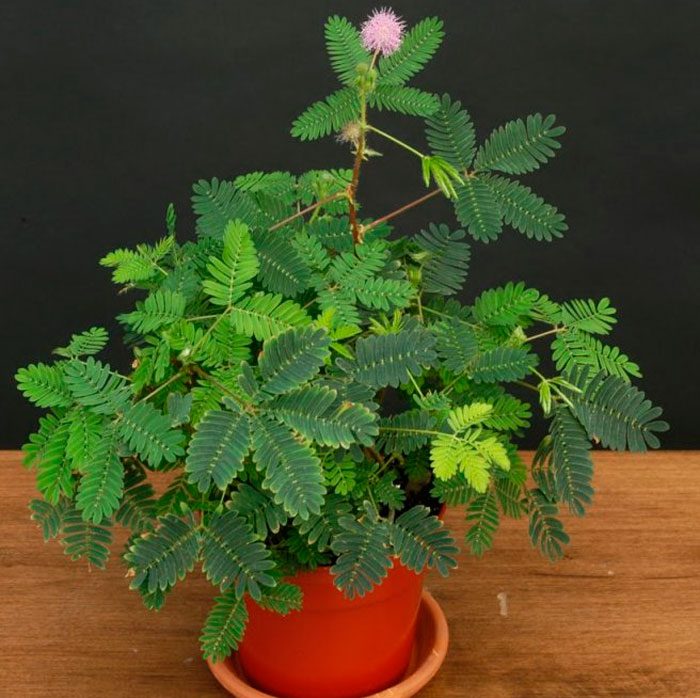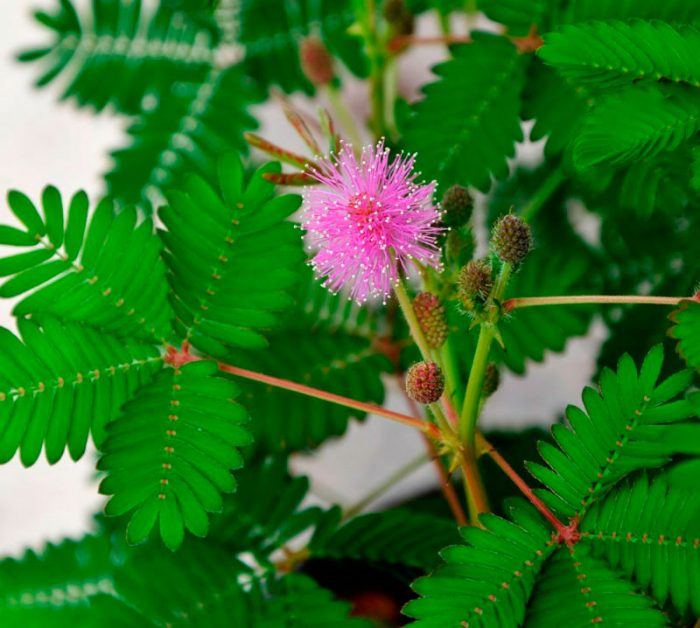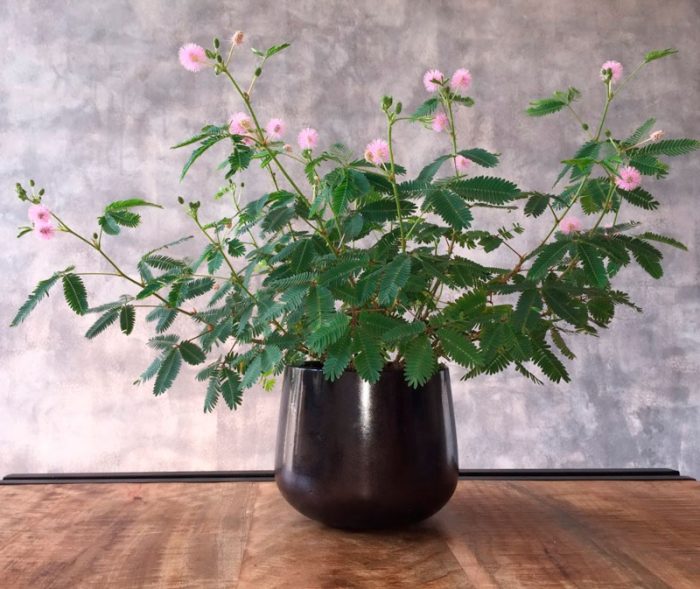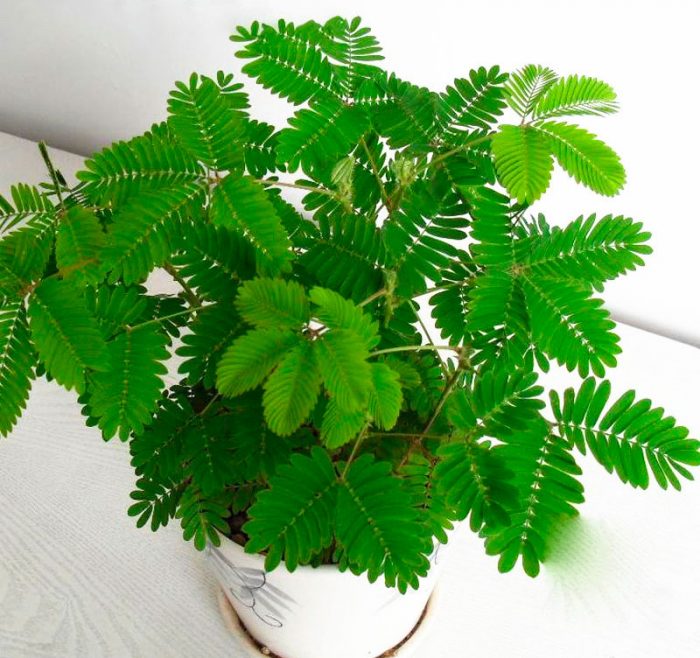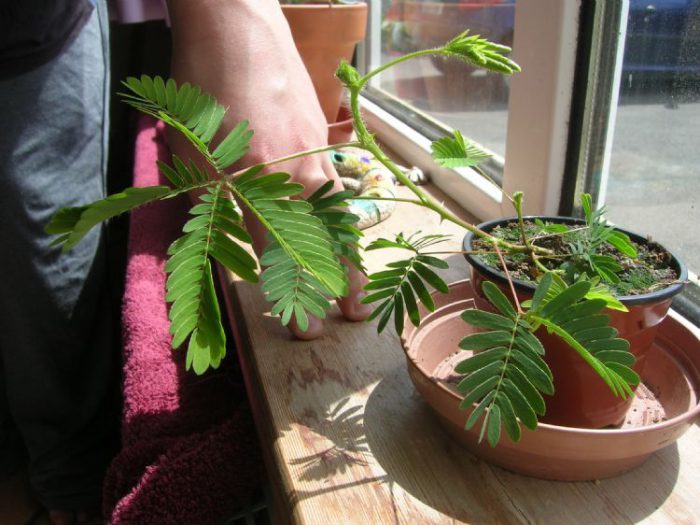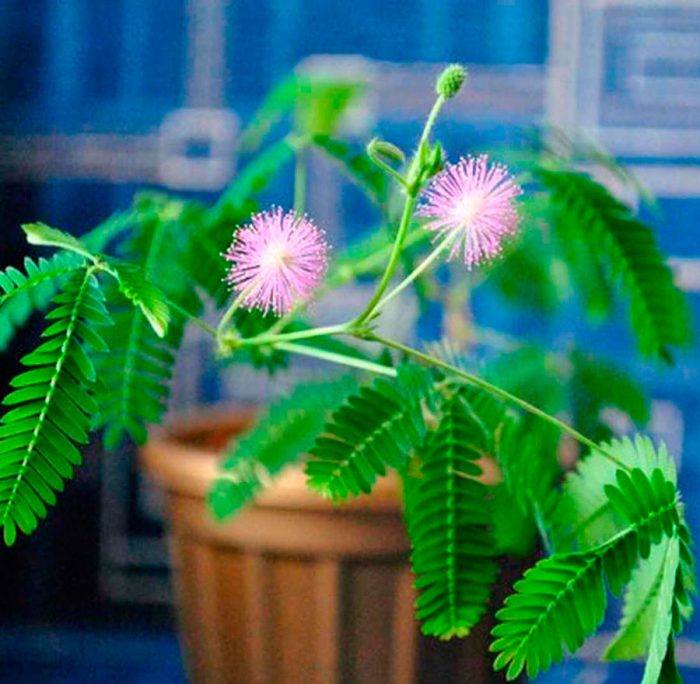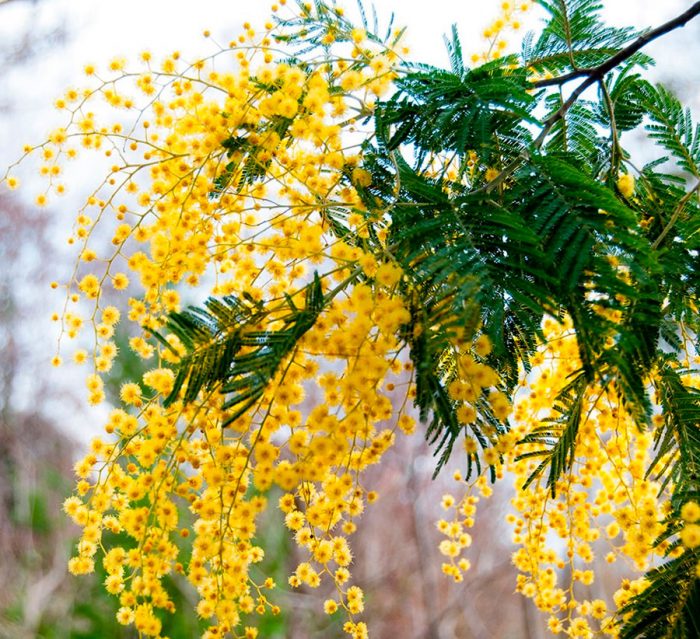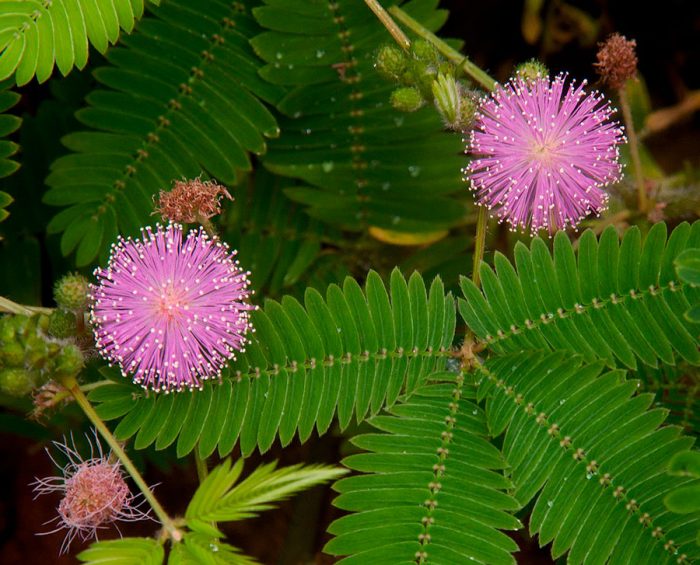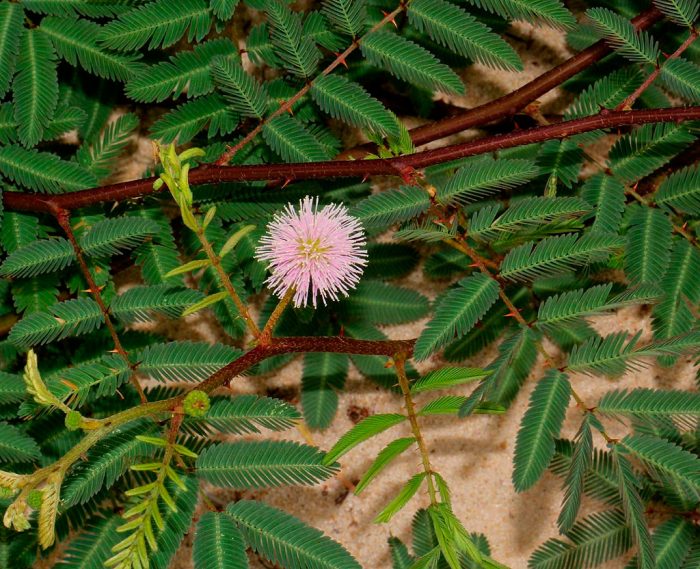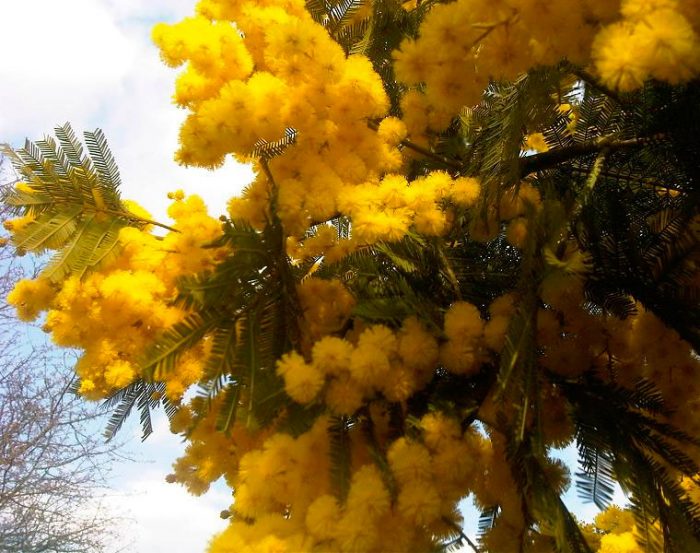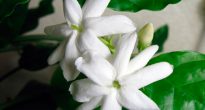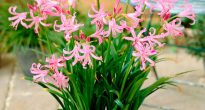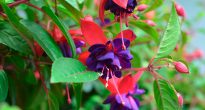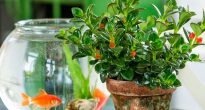The mimosa plant (Mimosa) belongs to the Mimosa family. Depending on the source, this genus unites from 300 to 450 different species. Under natural conditions, such a plant can be found in the tropical and subtropical latitudes of Africa, America and Asia.
Content
Features of mimosa
The genus of mimosa is represented by trees, shrubs and herbaceous plants. In culture, gardeners and florists grow only a part of the mimosa species. At the same time, the most popular with them is the bashful mimosa (Mimosa pudica). The capitate or spike-shaped inflorescences consist of small flowers. The stems are decorated with two-leafed leaf blades.
In flower arrangements, mimosa is often planted in the foreground, since its delicate inflorescences look very impressive against the background of other flowering plants. At the same time, it was noticed that such a plant looks most advantageous against a lighter background.
Brief description of cultivation
- Bloom... The bush blooms in spring, and flowering ends only in the last summer weeks.
- Illumination... A well-lit place is necessary.
- Temperature regime... In the period from March to September, the air temperature should be moderate (from 20 to 24 degrees), and in winter - within 15-18 degrees.
- Watering... In the spring and summer, they are watered abundantly, and in the cold season - moderately.
- Air humidity... It should be tall. Therefore, it is recommended to moisten the flower once a day from a spray bottle, and the water temperature should be close to room temperature. It is also recommended to pour expanded clay into the pallet and pour in a little water, and put a flower pot on top.
- Fertilizer... During the growing season, the bush is fed once every 15 days, using a mineral complex fertilizer for this, while taking a half dosage of that recommended on the package by the manufacturer.
- Dormant period... Not pronounced. However, in winter, the flower develops and grows more slowly.
- Transfer... Mimosa is grown as an annual. However, if such a need arises, then the bush is transplanted by the transshipment method. This procedure is carried out at the very beginning of the growing season.
- Soil mixture... It is necessary to mix in equal proportions peat, turf soil, humus and sand.
- Reproduction... By seed method.
- Pests... Spider mites and aphids.
- Diseases... Due to inappropriate growing conditions or disturbances in care, the foliage turns yellow and flies around, and the stems stretch out.
- Features:... In mimosa flowers, pollen is a strong allergen.
Home care for mimosa
Illumination
Indoor mimosa needs a lot of bright light, and direct sunlight does not harm it at all. That is why a south-facing window sill is perfect for this flower, but it can be placed on both the east and west windows. But at noon, when the sun is most active, it is still recommended to shade the bush for 2-3 hours, otherwise burns may form on the surface of its leaf plates. If the weather has been cloudy for a long time, then the bush should be accustomed to bright light gradually. The same applies to a newly acquired plant. Otherwise, the bright rays of the sun can burn the foliage.
Temperature regime
In the warm season (March – October), the flower should be provided with a moderate air temperature - 20–24 degrees. In winter, the room should be about 18 degrees, but not colder than 15 degrees.
Watering
Water intended for irrigation must first be defended for 12-24 hours, and it must be soft. The substrate is moistened as soon as its top layer dries, and in the winter months, watering should be moderate, and in the warm season - abundant. Mimosa will be negatively affected by both overdrying of the earthen coma and stagnation of fluid in the root system, especially during a cool winter.
Air humidity
In order for this culture to grow and develop well, it should be moistened at least once a day with well-settled soft water. Also, to increase the level of air humidity, a container with a flower can be installed on a pallet filled with wet expanded clay or pebbles. But make sure that the bottom of the pot does not come into contact with water.
Fertilizer
Top dressing of mimosa is carried out only in the summer. To do this, a solution of a mineral complex fertilizer is introduced into the substrate once every 2 weeks. In this case, the dosage used should be 2 times less than that indicated in the manufacturer's instructions.
Pruning
As a rule, at home, mimosa is cultivated as an annual. However, if you want the bush to decorate your home for two years, then you will need to prune the overly elongated shoots. Provide the bush with plenty of bright light and it will soon grow new shoots.
Mimosa transplant
Mimosa grown as an annual does not need replanting. If there is an urgent need for a transplant, then it is recommended to carry it out by the transshipment method, while the new container should be slightly larger than the old one. Don't forget to make a good drainage layer at the bottom of the pot. To prepare a suitable soil mixture, it is necessary to combine sand, sod soil, leaf humus and peat (1: 1: 1: 1).
Virulence
The pollen of this plant is the strongest allergen. Therefore, if you are allergic to pollen, then it is better to refuse to grow mimosa at home.
Growing from seeds
Already in the first year of growth on the mimosa bush, seeds ripen after flowering. In this regard, it is quite possible to reproduce it annually.
Sowing seeds is carried out in the first half of spring. The seedlings that appear should be dived into small pots, up to 70 mm in diameter. 2 or 3 plants are planted in one container. For picking, a soil mixture is used, consisting of leaf and sod soil, and also sand (2: 2: 1). After the root system becomes very cramped in the container, the bush is transplanted by transferring it into a new pot, reaching 11 centimeters in diameter.
In order for mimosa seeds to ripen at home, it needs a lot of bright light.


Watch this video on YouTube
Diseases and pests of mimosa
With poor care or in improper keeping conditions with mimosa, the grower may experience the following problems:
- Flying around foliage... This happens due to the fact that the soil mixture in the pot is moistened irregularly.
- Mimosa leaves turn yellow... This is to blame for the stagnation of fluid in the root system of the plant.
- Pulling shoots... If the mimosa does not have enough light, then its shoots stretch out and become lethargic.
- Lack of flowering... This can happen due to too little lighting or because the room is very cold.
- Pests... As a rule, spider mites and aphids most often settle on mimosa.
Types of mimosa with photos and names
Silver acacia (Acacia dealbata)
Silver acacia is a subspecies of mimosa, and it is its inflorescences that are most often used when creating bouquets. This plant quickly adapts to unfamiliar climatic conditions, and it can even be grown in regions with cool climates.
Such acacia is an evergreen plant, and in height it can reach about 10 m.However, where it comes from, there are specimens reaching a height of about 40 m. the branches are painted in a brownish-gray shade. While the shoots are young, they are colored greenish-silvery. In length, green leaf plates reach about 0.2 m, they have a slight silvery tint. The foliage is dissected, and about two dozen pairs of small leaves can be part of one plate.
Such a tree blooms magnificently. It forms yellow fragrant spherical paniculate inflorescences, which include small "balls". The inflorescence reaches an average of 0.7–0.8 cm across. When the tree has faded, fruits are formed on it, which are beans, colored in various dark shades. Beans can be several centimeters long. They have dense flat seeds about half a centimeter in size inside them.
Mimosa bashful (Mimosa pudica)
This perennial is native to South Africa, where it is considered a simple weed. This mimosa blooms very effectively: on long peduncles there are small spherical inflorescences of a purple hue. This species blooms from the last days of spring to the first weeks of autumn. The height of the bush can be up to 150 cm, but as a rule, it grows lower.
The peculiarity of this mimosa is in its response to external stimuli. For example, if a strong wind rises and starts to sway the bush, this can cause root injury. The bush reacts to this by releasing a poisonous substance that can greatly harm animals. It was also noticed that if you touch the foliage of this plant, then it begins to curl up. This is an unusual way to protect yourself from external factors.
Lazy mimosa (Mimosa pigra)
This species is an evergreen perennial. The peculiarity of this plant is that its shoots growing vertically upward are colored green. On average, the bush reaches a height of about 50 cm. It blooms effectively and magnificently. Snow-white not very large spherical inflorescences are collected in the upper part of the plant in a kind of "cap". Unusual foliage with its notches outwardly resembles fern leaves. This mimosa is suitable for growing both in the apartment and in the garden.
Rough mimosa (Mimosa scabrella)
Representatives of this species are both trees and shrubs. It can be cultivated both in indoor conditions and in a greenhouse, and its size will directly depend on where the bush grows. Originally from the warm regions of Central and South America, this species is not suitable for open field cultivation in mid-latitudes. On the surface of brown shoots, individual areas can be painted in more or less dark shades. Green leaves are small. Yellow inflorescences, shaped like a ball, are part of a kind of "panicles".When the bush fades, not very large fruits with dense seeds inside are formed on it.
Such a heat-loving plant reacts extremely negatively to a slight decrease in temperature and even to a slight draft. A slight cold snap can lead to the death of mimosa. It needs moderate watering, and it should not be allowed that direct rays of the sun fall on it for a relatively long time, as this can cause burns.


Watch this video on YouTube

